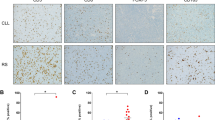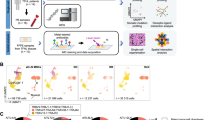Abstract
In a study of 157 patients with lymphoid malignancy, the phenotype of the tumour cells was correlated with the histological classification of the tumour using the Rappaport and the Kiel classifications. The markers used included E, Fc gamma, Fc micron (IgM) and C3d rosetting, estimation of SIg and CyIg, and tests for the expression of HTLA, Ia and ALL. Repeat biopsy specimens were studied in 23 of these patients. The phenotypic features of lymphoblastic malignancy indicated B-cell, T-cell and ALL-positive null-cell tumours in this group. Immunoblastic lymphomas were predominantly of non-capping B-cell type, but T-cell immunoblastic lymphoma occurred in 2 patients. Immunoblastic lymphomas of receptor-silent cells occur, and are ALL- and HTLA-negative. In the category of diffuse, poorly differentiated lymphocytic lymphomas, most cases are of centroblastic and centrocytic tumour of diffuse type, but pure centrocytic tumours and centroblastic tumours occur. The dominant phenotype in this group is of B cells expressing C3d receptors. Nodular poorly differentiated lymphocytic lymphomas (Rappaport) are classified as centroblastic and centrocytic follicular (Kiel) and most express SIg+ C3d+ phenotype. The frequency of this phenotype appeared the same in both diffuse and nodular poorly differentiated lymphocytic neoplasms. The Rappaport group of diffuse well-differentiated lymphocytic lymphoma includes 2 Kiel categories, malignant lymphoma lymphocytic, and malignant lymphoma lymphoplasmacytoid. Cells of the former tumour were considered to be immature B cells resembling those seen in CLL, and characteristically expressing SIg weakly, with a high frequency of single kappa light chain. Cells of the latter tumour are by contrast mature, and are related to the centroblastic and centrocytic follicular tumour by their histogenesis and phenotypic features. Repeat biopsy examinations indicate that T-cell predominance occurs in the prodromal phase of B-cell-predominant tumours of SIg+ C3d+ phenotype. It is concluded that non-Hodgkin lymphoma can be divided into 2 categories: (1) tumours of immature immunologically incompetent cells of lymphoblastic histology and with phenotypic features akin to T, B and Null-cell ALL, and (2) tumours of differentiated lymphocytes expressing the phenotypic features of B lymphocytes, with maturation arrested at one of several stages of an antigen-dependent immune response.
This is a preview of subscription content, access via your institution
Access options
Subscribe to this journal
Receive 24 print issues and online access
$259.00 per year
only $10.79 per issue
Buy this article
- Purchase on SpringerLink
- Instant access to full article PDF
Prices may be subject to local taxes which are calculated during checkout
Similar content being viewed by others
Rights and permissions
About this article
Cite this article
Habeshaw, J., Catley, P., Stansfeld, A. et al. Surface phenotyping, histology and the nature of non-Hodgkin lymphoma in 157 patients. Br J Cancer 40, 11–34 (1979). https://doi.org/10.1038/bjc.1979.137
Issue date:
DOI: https://doi.org/10.1038/bjc.1979.137
This article is cited by
-
Histological, immunohistological and autopsy findings in lymphogranulomatosis X (including angio-immunoblastic lymphadenopathy)
Virchows Archiv A Pathological Anatomy and Histopathology (1985)
-
Heterogeneity of T-cell neoplasias as defined by monoclonal antibodies
Klinische Wochenschrift (1983)
-
The analysis of lymphoid subpopulations in normal and malignant tissues by immunofluorescence technique
Journal of Cancer Research and Clinical Oncology (1981)



